RESEARCH ARTICLE
Compressive Strength Dependency on the Effect of Temperature Variation on the Percentages of Steel Fiber in Concrete
Dafe Aniekan Emiri1, Paschal Chimeremeze Chiadighikaobi2, *, Prosper Ng’andu3
Article Information
Identifiers and Pagination:
Year: 2023Volume: 17
E-location ID: e187483682301240
Publisher ID: e187483682301240
DOI: 10.2174/18748368-v17-e230202-2022-17
Article History:
Received Date: 03/10/2022Revision Received Date: 11/12/2022
Acceptance Date: 10/01/2023
Electronic publication date: 23/06/2023
Collection year: 2023

open-access license: This is an open access article distributed under the terms of the Creative Commons Attribution 4.0 International Public License (CC-BY 4.0), a copy of which is available at: https://creativecommons.org/licenses/by/4.0/legalcode. This license permits unrestricted use, distribution, and reproduction in any medium, provided the original author and source are credited.
Abstract
Aims:
The aim of this study is to check the effectiveness of steel fiber on the compressive strength of concrete.
Background:
Fibers have long been used as building materials to improve the ductility, tensile, compressive, and flexural strengths of concrete. Although fibers have been known as an effective reinforcement material for concrete structures, it is also acknowledged to be a suitable alternative to reinforcement steel bars.
Objective:
The objective of this research is to investigate some engineering properties, the compressive behavior of steel fiber reinforced concrete (SFRC), and the effect of elevated temperatures of up to 1000°C on concrete.
Methods:
Various tests which included the slump test, compressive strength test, as well as heating tests were done. The workability (slump) and thermal effects of M20 SFRC were evaluated.
Results:
Based on the results obtained, it could be observed that the workability of the M20 concrete reduced with the increase in steel fiber (SF) content from 0% to 1.6% as values obtained were 80mm, 73mm, 67mm, 61mm and 55mm for SF contents of 0%, 0.4%, 0.8%, 1.2%, and 1.6% respectively. These values showed medium workability of the concrete according to ASTM C-143/C-143 M-03. Also, the addition of SF to plain M20 concrete greatly improved the compressive strength (ƒc) with the concrete strength at 26.89N/mm2, 30.41N/mm2, 32.85N/mm2, 35.90N/mm2 and 39.66N/mm2 after 28 days of curing for steel fiber contents of 0%, 0.4%, 0.8%, 1.2%, and 1.6% respectively. The f_c after heating the concrete mix to 1,000°C showed improved thermal resistance with 4.2N/mm2, 8.23N/mm2, 11.63N/mm2, 15.60N/mm2 and 17.20N/mm2 for SF contents of 0%, 0.4%, 0.8%, 1.2% and 1.6% respectively.
Conclusion:
The incorporation of steel fibers in the concrete mix decreased the workability of SFRC but increased its compressive strength and balling tendencies.
1. INTRODUCTION
In the 21st century, concrete is seen as one of the most versatile, durable, with good thermal and mechanical properties, and efficiently usable construction material with a wide range of structural/ construction applications. However, being a quasi-brittle material is a significant demerit, when the strength of the material is intensified, its brittleness increases [1]. In contrast when ordinary concrete which possesses lower tensile strength and easy cracking propagating abilities is subjected to severe loading conditions [1-3]. Furthermore, current modern construction works demand concrete with a combination of qualities and properties such as higher strength, higher durability, toughness, and excellent thermal properties [1, 4, 5]. In addition, recent improvements in modern concrete, high-strength concrete (HSC), and fiber-reinforced concrete (FRC), offer some outstanding properties [4, 5].
Concrete possesses some impressive features which include excellent compressive strength (ƒc), durability, affordability, and easily available subcomponents. The use of fibers in reinforcing brittle concrete materials is dated back to the civilization time of the Egyptian and Babylonian even before cement was invented [6]. Fiber-reinforced concrete (FRC) is concrete that consists of cement mortar and randomly oriented, discontinuous, uniform fibers [7]. The addition of Steel fiber (SF) in concrete as concrete reinforcement minimizes the brittleness and tensile capacity of concrete [8].
Multiple studies done earlier to improve the mechanical properties of concrete by combining different types of fibers [9-18] into its structure, healed cracks and increased the ductility of concrete elements [19]. Many research groups have studied and proven the properties of various composites produced by fiber insertion, including cement-based materials reinforced with agro-industrial residuals, recycled polyethylene terephthalate, vegetal, glass, basalt fibers (BF), and SF [20-26]. Moreover, the addition of fibers to a concrete matrix improved its durability by exhibiting pseudo-ductile behavior (residual strength against the applied force after cracking) [27]. The performance of fibers for concrete reinforcement depends on their parameters such as aspect ratio (AR), volume fraction, size distribution, and shape [28]. Concrete is in very high demand due to these remarkable features. Concrete ensures a strong, reliable, and durable structure [29]. Steel fibers reinforced concrete (SFRC) behavior can be classified into three groups, namely, fiber volume, percentage, and fiber effectiveness [30].
SF has four major features which affect its properties. The features are types including shape, volume fraction, aspect ratio (the ratio of length to the diameter of the SF), and orientation of fibers in the matrix. Recently, these parameters have been studied to optimize them and improve the quality of the SF [31]. Studies on other fibers show that they retain their sustainability under high temperatures [32].
Many researchers have been able to discover that adding SF to a concrete mixture improves its ƒc This increase can either be marginal or significant increases in ƒc Fibers can affect the ƒc of concrete which is based on two stabilizing actions according to the study [33, 34]. Firstly, the large number of pore spaces in the concrete admixture reduces its ƒc nd secondly, when the fiber bridges micro-cracks, it causes an increase in the ƒc Hence, how SF affects the ƒc depends on the concrete mix, the type and quantity of SF, and the manufacturing process. Adding up to 1.5% of SF by the volume of concrete increases its ƒc from 0 to 15%.
One of the factors affecting concrete properties is increased temperatures [35, 36]. Temperature affects the ƒc of concrete negatively and leads to cracking and spalling in concrete. Temperature is also one of the main factors that reduce load bearing capacity of concrete, cement paste, and aggregate bonding strength and leads to the gradual destruction of its gel structure [37, 38]. Multiple studies of the mechanical properties of SFRC exposed to high temperatures have been performed [39-42]; the strength reduction and surface cracking pheno-mena observed for various fiber-reinforced concrete have been described [43].
However, the research on concrete deterioration at high temperatures represents a challenging task because of the different properties of its structure [44]. The strength of concrete and the modulus of elasticity (E) is reduced due to the negative effects of increased temperature on the microstructure (thermochemical decomposition and excessive microcracking) and the macrostructure (abrasion and chipping). Furthermore, due to the loss of water by hydrated silicate species, the strength of cement paste decreases after heating to temperatures above 300°C. (the process is accelerated in the temperature region between 500 and 600°C because of the calcium hydroxide dehydration). As a result, the cement starts shrinking [45], and the strength reduction of the cement is relatively insignificant for temperatures below 200°C, in the region from 200°C to 300°C, the weakening of the van der Waals force between various C–S–H layers occurs because of the water evaporation (both these factors contribute to the loss of concrete strength) [45, 47]. In the temperature region from 300°C to 600°C, the corresponding reduction in strength amounts to 50%–90%. Between 600°C and 900°C, the related strength reduction becomes equal to 90% [45, 46, 48]. At temperatures above 1000 °C, its residual strength is reduced to zero [45]. Nevertheless, after the elevation of temperatures above 600°C, the structural resistance of concrete becomes zero [49]. At a temperature of 500°C, the concrete suffers a 55%–70% loss of its initial strength [50].
Some high-temperate nations have high temperatures up to 55°C therefore concrete structures in such countries are exposed to such high temperatures which expose the structure to the risk of failure ranging from degradation, cracks, etc. Although, when concrete structures are exposed to fire outbreaks, high temperatures, or more heat production activities pose a high risk, hence the experimental research conducted by this paper exposes the concrete to a temperature as high as 1000°C.
Concrete structures become more brittle when exposed to high temperatures. High temperatures can arise in structures because of fire outbreaks in or within the structure, and excessive heat from machinery which is generated from the emission, vibration, and friction from the machines. The above problems which occurrin concrete structures expose the structure to loss of strength. Therefore, the objective of this research is to solve these problems and investigate the effect of dispersed SF in concrete when exposed to high temperatures. The fire resistance and post-heat exposure behavior of structural members depend on the thermal and mechanical properties of the materials composing these members. ƒc is one of the major properties which play an essential role in the structural behavior of reinforced concrete members both before and after high-temperature exposure.
Naturally, concrete has brittle properties, even more, brittle when exposed to high temperatures. High-temperate nations tend to experience a high collapse of concrete structures because of certain properties that must be strengthened. It has become a necessity to strengthen the concrete to maintain its sustainability and be less cost-effective, hence the reason for the incorporation of steel fibre in the concrete mix.
This research investigates how temperature affects the SFRC and its goal was to:
i Find a solution to concrete brittleness by incorporating SF into the concrete mix.
ii Identify the workability of the SFRC.
iii Find a sustainable solution to the fast cracking and degradation of concrete structures when exposed to elevated temperatures.
iv Investigate the ƒc of the SFRC with an increment in temperature.
To reach the objectives, solving and achieving the goals mentioned above are of utmost importance.The experimental work done in this research includes investigating and evaluating the fresh and hardened properties of concrete for both plain concrete and SFRC. Moreover, there will be a comparison between SFRC and plain (control) concrete to determine which of the two concrete types gives better overall performance. Several tests including slump, ƒc and heating was carried out and applied to determine the softness and hardness of the properties of fiber-reinforced concrete (FRC). Most of the research work done so far which has been published shows that in the concrete mix, a water-reducing agent was used but the use of water reducing agent is not a common practice in Nigeria as most noncommercial or non-public structures were constructed without any water reducing agent. The practice of SF incorporation is not a common practice in Nigeria therefore, it will be an eye-opener for the Nigerian environment.
The use of dispersed SF wires can be considered as a solution to control cracking and increase the strength of concrete. Since exposure to high temperatures causes different changes in concrete which leads to the initiation and opening of many cracks.
2. RESEARCH METHODOLOGY
In this research paper, compression tests on the SFRC and plain concrete specimens as a control, 7 tests with normal temperature, and the effect of elevated temperature on the ƒc were conducted. Moreover, a slump test was done to check the workability of the concrete paste. Tests and experiments are conducted following BS (2019) EN 12350-2 [51], BS (2019) EN 12390-2 [52], and BS (2019) EN 12390-3 [53]. To achieve the objective of this research, the following materials were used to produce the concrete mix series.
3. EXPERIMENTAL MATERIALS
3.1. Fine Aggregate
Quartz sand with fractions ranging from 0.6mm to 0.8mm was used. The sand has a rounded part with a low content of clay inclusions and inclusions of soft rocks. The moisture content is up to 0.2% [54]. The quartz used in this experiment was obtained from a construction company yard in Calabar, Cross River State, Nigeria. The physical properties of quartz sand are presented in Table 1. This type of sand is used in the construction industry as fillers, they have high anti-erosion ability, and they are used to make acid-resistant concrete and mortar [55].
| Physical Property | Value |
| Grain size, [mm] | 0.5-0.9 |
| Bulk density (compacted), [kg/m3] | 1427 |
| Hardness (on the Mohs scale) | 7.1 |
| Crushability | 0.4 |
| Humidity, [%] | 1.6 |
3.2. Cement
Dangote 3X Portland Limestone Cement 42.5N. According to BSI. 1978. BS 4550-3.4:1978 [56], from the information provided, the properties of Dangote 3X Portland Limestone Cement 42.
5 N are as follows: Portland-limestone cement with a limestone content ranging from 6% to 20% by mass, a total organic content (TOC) of no more than 0.50 percent by mass (L), a strength class of 42.5, and an ordinary early strength. The chemical and mineral compositions of Dangote 3X Portland cement in percentages are illustrated in Table 2.
| Chemical Composition | |||||||||||
| SiO2 | Al2O3 | Fe2O3 | K2O | CaO | MgO | SO3 | Na2O | ||||
| 22 | 5.6 | 5.2 | 0.58 | 64 | 1.21 | 2.3 | 0.39 | ||||
| Mineral Percentage Composition | |||||||||||
| C3S | C2S | C3A | C4AF | Total Sum (Σ) | |||||||
| 33.33 | 26.47 | 14.33 | 4.77 | 78.9 | |||||||
3.3. Coarse Aggregate
Granite (Fig. 1) was used as the coarse aggregate for the concrete mix with granite passing through 12.5mm sieves and retained on a 10 mm sieve. This was to ensure that smaller sizes of aggregates were used to prevent a reduction in workability as larger sizes of coarse aggregates resulted in reduced workability in fiber reinforced concretes. One of the materials traditionally used in the construction of monuments is Granite. This is because of its durable properties and its ability to withstand extreme weather conditions [57]. Table 3 shows the chemical composition of granite.
3.4. Steel Fiber (SF)
SF (Fig. 2) of low carbon wire of length 50 mm and diameter of 1 mm were used. Table 4 shows the steel fiber characteristics and specifications. The steel was purchased from the company “Steel Fiber” located in Russia.
| Name | SiO2 | Al2O3 | K2O | Na2O | CaO | FeO | Fe2O3 | MgO | TiO2 | P2O5 |
| Percentage | 72.04% | 14.42% | 4.12% | 3.69% | 1/82% | 1.68% | 1.22% | 0.71% | 0.30% | 0.12% |
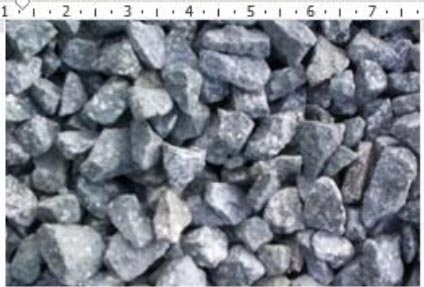 |
Fig. (1). Granite for concrete coarse aggregate. |
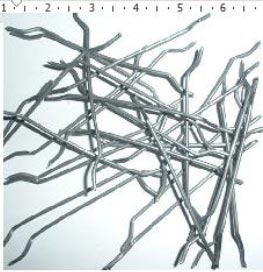 |
Fig. (2). Steel fiber. |
| Specifications | ||||
| Material | Low carbon wire | |||
| Special coating | Bronze, unplated | |||
| Geometry | Anchor | |||
| Fiber length | L = 50 mm | |||
| Fiber diameter | Ø = 1 mm | |||
| Anchor length | 4±3mm | |||
| Anchor bend height | 3±2mm | |||
| Straight section length | 38±4mm | |||
| Number of bends | 4 things | |||
| Tensile strength | from 1100 MPa | |||
| Dosage | from 25 kg/m3 | |||
| Characteristics | ||||
| ρ, g/cm3 | Ø, µm | E, GPa | ft, MPa | Elongation at break, % |
| 7.8 | 200-1200 | 190-210 | 500-1500 | 3-4 |
3.5. Water
Pipe or portable drinking water is widely used in mixing concrete. The water used for mixing and curing concrete must be free from suspended particles, chemical substances, and biological elements [58].
3.6. Experimental Procedures
In this study, the experimental tests were conducted on 5(five) different mixes of concrete comprising 0% SF (plain concrete or control specimen), 0.4% SF, 0.8% SF, 1.2% SF and 1.6% SF by weight percentage (Table 5). The concrete mix contained an SF of Ø1mm and a length of 50mm.
| SF Contents (%) | Weight of Total Aggregate Concrete Mix (Kg) | Weight of SF in Mix (Kg) |
| 0% | 27.5 | 0 |
| 0.4% | 27.61 | 0.11 |
| 0.8% | 27.72 | 0.22 |
| 1.2% | 27.83 | 0.33 |
| 1.6% | 27.94 | 0.44 |
| Total | 138.6 | 1.1 |
The following parameters were used for the various experiments to prepare the concrete mix series:
- Weight of cement: 25kg + Weight of fine aggregate (sand): 37.5kg + Weight of coarse aggregate (Granite): 75kg = Total weight of aggregate: 137.5kg.
- Using a water-cement ratio of 0.5, the total weight of water for the entire concrete mix was 12.5kg, i.e., the weight of cement x 0.5 = 12.5kg, with a volume of 12.5 liters.
- Since each mix contained varying percentages of SF, ranging from 0% to 1.6% of the aggregate’s weight, the total concrete mix was divided into 5 parts (for the five (5) percentages of SF content). Therefore, the amount of water for each part weighed 2.5kg with a volume of 2.5 liters.
- Hence, the weight of aggregate for each part is 137.5/5 = 27.5kg and the weight of each concrete mix was 30kg.
To prepare the concrete cube specimens needed to achieve the objectives of this study, the aggregates were mixed with water in an electric concrete mixer at a temperature of 28°C, the ratio of water-cement used for the concrete mix was 0.5. This implied that for every 100kg of cement, 50kg of water was added. This was within the acceptable range of 0.4 to 0.6 for fiber reinforced concretes (FRC). After mixing, the concrete paste was tested for a slump, and then cast in cube molds of dimension 100 x 100 x 100 mm, then the molds were covered with damped wool clothes for 24 hours under temperature 20±5°C and air-humidity 95 ± 5% then, demolded. A control concrete grade of M20 (the articulated compressive strength to be achieved) was made with a mix ratio of 1:1.5:3. The solid demolded concrete cube specimens were placed in a curing tank of dimensions 0.8m x 1.0m x 1.5m. Full submersion of the cubes was done to ensure uniform curing until the specific testing day. On day 28, 5 (five) concrete series were tested under individual temperatures of 28oC, 50oC, 100oC, 150oC, 200oC, 250oC, 400oC, 500oC, 750oC, and 1,000oC where 28oC was the room temperature of the laboratory where the concrete cube specimens were kept when removed from the curing bath. To achieve the temperature needed, an electric furnace was used to heat the concrete cubes at temperatures 50oC, 100oC, 150oC, 200oC, 250oC, 400oC, 500oC, 750oC, and 1,000oC. The concrete cubes of 0% SF, 0.4% SF, 0.8% SF, 1.2% SF, and 1.6% SF were placed inside the furnace and heated to the required temperature; the temperature was raised at a rate of 50°C/min. The concrete cubes were then taken out at the interval of 5 minutes to measure the temperature of the cube. Once the desired temperature is reached, the concrete cube was removed and taken out for cooling, then it was crushed.
. The compression test experiments were carried out on a Universal Testing Machine with a maximum load of 1500kN for compression until failure obtaining the ƒc by placing a cube specimen vertically with one surface serving as the support and the other surface serving as the load surface (Fig. 3).
The tests to determine the ƒc of the concrete cube, specimens were conducted on days 3, 7, 14, 21, and 28 per 3(three) concrete cube specimens of each of the concrete mix series. A total number of 210 concrete cube specimens were prepared. From each of the 3(three) cubes, an average of the ƒc was taken.
The following tests were conducted: slump test, ƒc test, as well as compression tests. A slump test was done to determine the workability of freshly mixed concrete while the ƒc test was done to determine the strength of concrete in a controlled environment.
4. RESULTS AND DISCUSSIONS OF THE EXPERIMENTAL TEST OUTCOME
4.1. Slump Test
From the slump test carried out, there were reductions in the values of the slump with increased SF content (Fig. 4). This shows that the workability of concrete reduced with the increase in SF content. Regarding the concrete series with 0% SF, the concrete series reinforced with 0.4% SF reduced its workability by 8.75%, 0.8% SF reduced by 16.25%, 1.2% SF reduced by 23.75%, and 1.6% SF reduced the concrete workability by 31.25%.
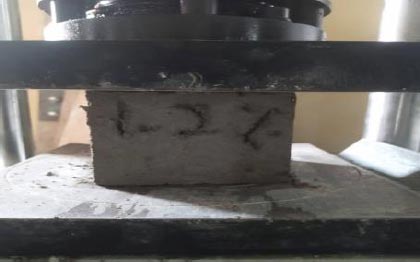 |
Fig. (3). A concrete cube in a compressive test machine. |
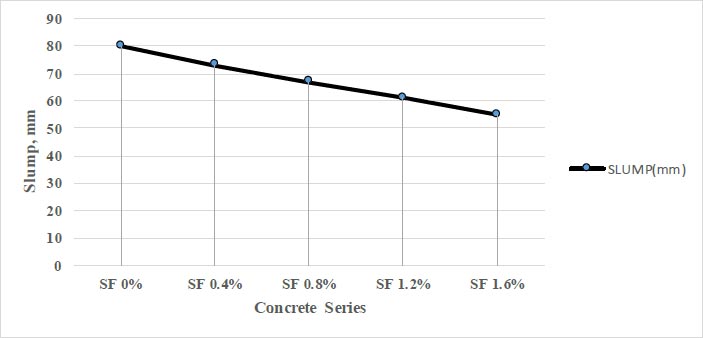 |
Fig. (4). Workability (Slump) concrete and SFRC. |
4.2. Compressive Strength (FC )
Fig. (5) shows the average ƒc the test result is taken from three samples of concrete cubes on day 3 (three). It was observed that the addition of SF improves the overall ƒc of the concrete. The concrete with 0% SF content had the least strength as compared with other SFRCs. Higher ƒc levels were obtained by increasing SF%. The concrete with 0.4% SF content improved the early strength of the concrete by 7%, while concrete with 0.8% SF, 1.2% SF, and 1.6% SF increased the early ƒc by 24.8%, 44.9%, and 50.3% respectively.
The ƒc on day 7 is shown in Fig. (5). It can be observed that 0.4% SF enhanced the concretes ƒc after 7 days by 4.3% while SF contents of 0.8%, 1.2%, and 1.6% improved the ƒc by 19.4%, 24.1%, and 28.7% respectively as compared to concrete with 0% SF content. It can also be observed that there was a 39.8% increase in ƒc of the concrete with 0% SF content between day 3 and day 7. Subsequently, concrete with 0.4%, 0.8%, 1.2%, and 1.6% SF increased in ƒc by 29.9%, 33.8%, 19.7%, and 19.7% respectively. This demonstrates that the full strength of concrete is not achieved instantly but gradually.
Results from ƒc test carried out on the various specimens after 14 days (Fig. 6) of curing shows that 0.4% SF enhanced the concretes ƒc after 14 days by 24.2% while SF contents of 0.8%, 1.2%, and 1.6% improved the ƒc by 39.5%, 54.8%, and 62.9% respectively as illustrated in Fig. (5).
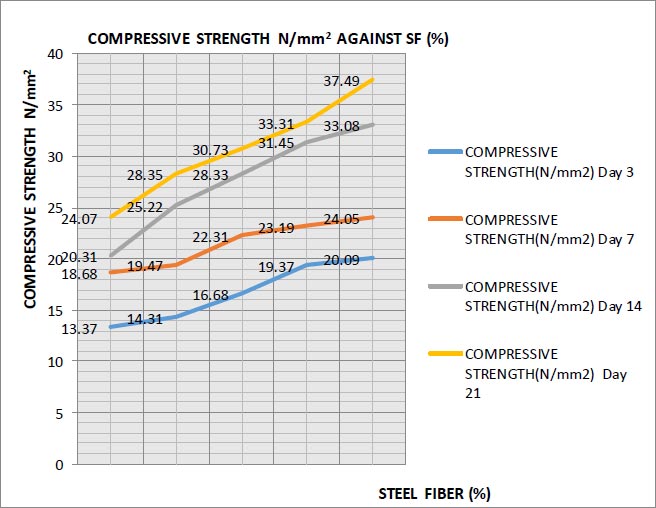 |
Fig. (5). The increment in the strength of the concrete cubes after 3 to 21 days of curing. |
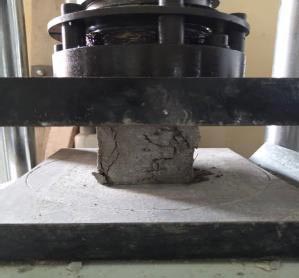 |
Fig. (6). FC test of SFRC on day 14. |
Results obtained from the ƒc test carried out on the various concrete specimens after 21 days of curing shows that there was an 18.5% increase in ƒc of the concrete with 0% SF content between day 14 and day 21. Subsequently, concrete with 0.4%, 0.8%, 1.2%, and 1.6% SF increased in ƒc by 12.4%, 8.5%, 5.9%, and 13.3% respectively. This percentage increase in ƒc between days 14 and 21 can be seen in Fig. (5). It can be observed that 0.4% SF enhanced the concretes ƒc after 21days of curing by 17.8%, while 0.8% SF, 1.2% SF, and 1.6% SF improved the ƒc by 27.7%, 38.4%, and 55.8% respectively.
The results of the ƒc against SF content from days, 3 to day 28 of curing are illustrated in Fig. (7).
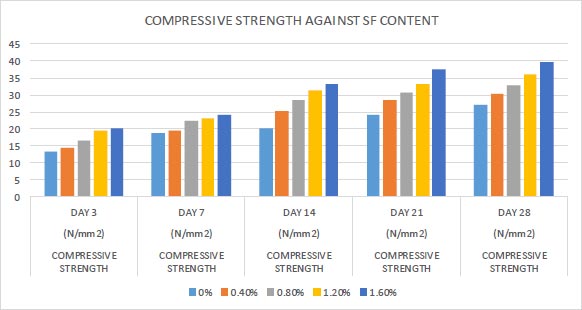 |
Fig. (7). Compressive strength with steel fiber content from day 3 to day 28.. |
Table 6 shows the combined ƒc taken from the average of three concrete cube samples from day 3 to day 28.
Table 7 shows the average results obtained from 210 concrete cubes which are, 70 ƒc results subjected to T ranging from 28°C to 1,000°C where 28°C is the T in the laboratory in which the experiments were conducted.
Fig. (8) below shows the ƒc comparison of the various SF concrete cubes being subjected to heating at an elevated T. Table 8 shows the concrete cubes subjected to T ranging from 28°C to 1,000°C.
| SF (%) | DAY 3 | DAY 7 | DAY 14 | DAY 21 | DAY 28 |
| ƒc (N/mm2) | |||||
| 0 | 13.37 | 18.68 | 20.31 | 24.07 | 26.89 |
| 0.4 | 14.31 | 19.47 | 25.22 | 28.35 | 30.41 |
| 0.8 | 16.68 | 22.31 | 28.33 | 30.73 | 32.85 |
| 1.2 | 19.37 | 23.19 | 31.45 | 33.31 | 35.90 |
| 1.6 | 20.09 | 24.05 | 33.08 | 37.49 | 39.66 |
| T °C) SF % |
28°C | 50°C | 100°C | 150°C | 200°C | 250°C | 400°C | 500°C | 750°C | 1,000°C |
| ƒc N/mm2 | ||||||||||
| 0 | 26.89 | 26.68 | 26.10 | 25.50 | 24.71 | 23.11 | 20.31 | 18.22 | 13.50 | 4.2 |
| 0.4 | 30.41 | 30.30 | 29.90 | 29.50 | 27.81 | 26.90 | 23.80 | 21.90 | 16.81 | 8.23 |
| 0.8 | 32.85 | 32.75 | 32.35 | 32.05 | 31.50 | 30.80 | 28.50 | 26.81 | 19.55 | 11.63 |
| 1.2 | 35.90 | 35.82 | 35.42 | 33.40 | 32.24 | 31.95 | 29.10 | 28.70 | 23.20 | 15.60 |
| 1.6 | 39.66 | 39.63 | 39.40 | 38.19 | 37.20 | 36.30 | 35.00 | 34.21 | 25.96 | 17.20 |
| SF (%) | DAY 3 | DAY 7 | DAY 14 | DAY 21 | DAY 28 |
| ƒc (N/mm2) | |||||
| 0 | 13.37 | 18.68 | 20.31 | 24.07 | 26.89 |
| 0.4 | 14.31 | 19.47 | 25.22 | 28.35 | 30.41 |
| 0.8 | 16.68 | 22.31 | 28.33 | 30.73 | 32.85 |
| 1.2 | 19.37 | 23.19 | 31.45 | 33.31 | 35.90 |
| 1.6 | 20.09 | 24.05 | 33.08 | 37.49 | 39.66 |
| T °C) SF % |
28°C | 50°C | 100°C | 150°C | 200°C | 250°C | 400°C | 500°C | 750°C | 1,000°C | |
| ƒc N/mm2 | |||||||||||
| 0 | 26.89 | 26.68 | 26.10 | 25.50 | 24.71 | 23.11 | 20.31 | 18.22 | 13.50 | 4.2 | |
| 0.4 | 30.41 | 30.30 | 29.90 | 29.50 | 27.81 | 26.90 | 23.80 | 21.90 | 16.81 | 8.23 | |
| 0.8 | 32.85 | 32.75 | 32.35 | 32.05 | 31.50 | 30.80 | 28.50 | 26.81 | 19.55 | 11.63 | |
| 1.2 | 35.90 | 35.82 | 35.42 | 33.40 | 32.24 | 31.95 | 29.10 | 28.70 | 23.20 | 15.60 | |
| 1.6 | 39.66 | 39.63 | 39.40 | 38.19 | 37.20 | 36.30 | 35.00 | 34.21 | 25.96 | 17.20 | |
From Fig. (8), it can be observed that plain M20 concrete (0% SF) losses 0.78%, 2.93%, 5.16%, 8.10%, 14.1%, 24.47%, 32.32%, 49,79% and 84.38% respectively of its ƒc at 28°C, 50°C, 100°C, 150°C, 200°C, 250°C, 400°C, 500°C, 750°C, and 1000°C respectively.
Concrete incorporated with 0.4% SF losses, 0.36%, 1.67%, 2.99%, 8.55%, 11.54%, 21.74%, 27.98%, 44.72% and 72.94% respectively of its ƒc at 28oC, 50oC, 100oC, 150oC, 200oC, 250oC, 400oC, 500oC, 750oC and 1,000oC respectively Table 9.
Concrete with 0.8% SF losses 0.30%, 1.52%, 2.43%, 4.11%, 6.244%, 13.24%, 18.39%, 40.49% and 64.60% respectively of its ƒc at 28oC, 50oC, 100oC, 150oC, 200oC, 250oC, 400oC, 500oC, 750oC and 1,000oC respectively.
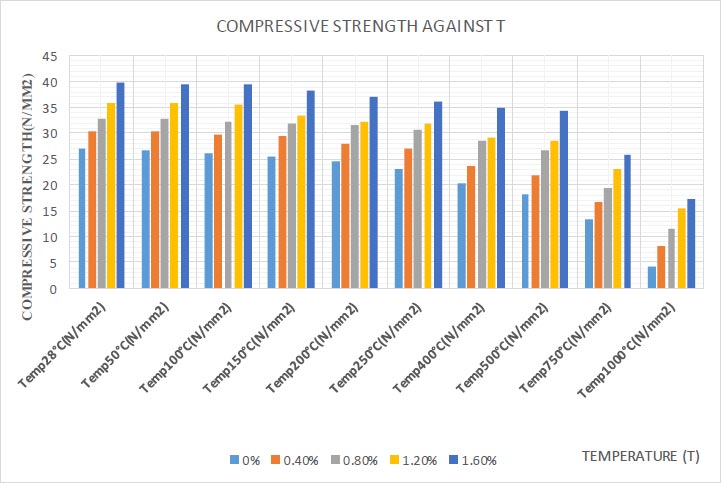 |
Fig. (8). ƒc a varying percentage of SF concrete cubes subjected to elevated T. |
1.2% SF concrete losses 0.22%, 1.34%, 6.90%, 10.19%, 11.00%, 18.94%, 20.06%, 35.37% and 56.55% respectively of its ƒc at 28oC, 50oC, 100oC, 150oC, 200oC, 250oC, 400oC, 500oC, 750oC and 1,000oC respectively.
Concrete with 1.6% SF losses 0.076%, 0.66%, 3.71%, 6.20%, 8.47%, 11.74%, 13.74%, 34.54% and 56.63% respectively its ƒc at 28oC, 50oC, 100oC, 150oC, 200oC, 250oC, 400oC, 500oC, 750oC and 1,000oC respectively.
From the results obtained, it can be observed that the addition of SF significantly increases the overall compressive strength of concrete when it was exposed to a high T of up to 1,000oC. Moreover, from the results, concrete cubes with 1.6% of SF contents had the highest ƒc hence signifying that the most effective proportion of the various SF percentages under consideration is 1.6% SF content.
CONCLUSION
From the experimental results, it can be observed that:
1. The workability of SFRC decreases with the addition of more amount of SF to the concrete mix. This is in line with the research carried out by R.N Swamy [9]. Where he stated that the increase in the aspect ratio and volume of fibers would result in reduced workability and increased balling tendency.
2. The ƒc tests demonstrate that increments in the ƒc of concrete cubes was caused by the increase in the incorporation of SF. Hence, we can affirm that SF percentages of 0.4%, 0.8%, 1.2%, and 1.6% yielded the best results.
3. As expected, the concrete cubes reached full strength after 28 days in the curing tank.
4. 1.6% of SF content gave the best ƒc alues when compared with the other percentages of SF under consideration within the scope of this research.
5. The heating test results show that SF significantly enhances the thermal resistance of plain concrete hence improving its ƒc after it has been subjected to heating of up to 1,000oC.
6. Hence, we can conclude that SF improves the ƒc of concretes as well as enhance their thermal resistance, and the same can be said for all SF percentages under consideration.
LIST OF ABBREVIATIONS
| HSC | = Highstrength Concrete |
| FRC | = Fiber-Reinforced Concrete |
| SF | = Steel Fiber |
| SFRC | = Steel Fibers Reinforced Concrete |
CONSENT FOR PUBLICATION
Not applicable.
AVAILABILITY OF DATA AND MATERIALS
The data supporting the findings of the article is available with in the article.
FUNDING
None.
CONFLICT OF INTEREST
The authors declare no conflict of interest, financial or otherwise.
ACKNOWLEDGEMENTS
The authors gratefully acknowledge Mr. M. P. Akomaye a Technologist in the Civil Engineering department of CRUTECH for providing technical support. The efforts of Mr. Ogarekpe Mba Ogarekpe a past undergraduate student of the Civil Engineering department of CRUTECH are recognized.
REFERENCES
| [1] | S. P. Shah, High Performance Concrete.. McGraw-Hill Companies, 1994. |
| [2] | V. Afroughsabet, and T. Ozbakkaloglu, "Mechanical and durability properties of high-strength concrete containing steel and polypropylene fibers", Constr. Build. Mater., vol. 94, pp. 73-82, 2015. |
| [3] | P.C. Aïtcin, High performance concrete.. Spon: London, 1998. |
| [4] | P.S. Song, and S. Hwang, "Mechanical properties of high-strength steel fiber-reinforced concrete", Constr. Build. Mater., vol. 18, no. 9, pp. 669-673, 2004. |
| [5] | Y. Farnam, S. Mohammadi, and M. Shekarchi, "Experimental and numerical investigations of low velocity impact behavior of high-performance fiber-reinforced cement based composite", Int. J. Impact Eng., vol. 37, no. 2, pp. 220-229, 2010. |
| [6] | E.G. Nawy, Fundamentals of High Strength High Performance Concrete.. Addison-Wesley Longman, 1996. |
| [7] | M.S.J. Gani, Cement and Concrete.. Chapman & Hall: London, 1997. |
| [8] | Y. Guo, J. Zhang, G. Chen, and Z. Xie, "Compressive behaviour of concrete structures incorporating recycled concrete aggregates, rubber crumb and reinforced with steel fibre, subjected to elevated temperatures", J. Clean. Prod., vol. 72, pp. 193-203, 2014. |
| [9] | R.N. Swamy, Testing and Test methods of Fiber Cement Composites.. 1978, pp. 42-43. |
| [10] | M.A. Tantary, A. Upadhyay, and J. Prasad, Steel fibre based concrete in its fresh state.. ICI Journal, 2008, pp. 13-22. |
| [11] | S. Kinnunen, and H.S.E. Nylander, Punching of Concrete Slabs Without Shear Reinforcement.. Royal Institute of Technology: Stockholm, Sweden, 1960. |
| [12] | D.C. Mckee, The Properties of an Expansive Cement Mortar Reinforced with Random Wire Fibers., Ph.D. Thesis, University of Illinois, Urbana-Champaign, IL, USA, 1969. |
| [13] | L.E. Nielsen, and P.E. Chen, "Young’s modulus of composites filled with randomly oriented fibers", J. Mater., vol. 3, pp. 352-358, 1968. |
| [14] | J.P. Romualdi, and J.A. Mandel, "Tensile strength of concrete affected by uniformly distributed and closely spaced short lengths of wire reinforcement", J. Proc., vol. 61, pp. 657-672, 1964. |
| [15] | S.P. Shah, and B.V. Rangan, "Fiber Reinforced Concrete Properties", J. Am. Concr. Inst., vol. 68, no. 2, pp. 126-137, 1971. |
| [16] | S. Guler, D. Yavuz, and M. Aydın, "Hybrid fiber reinforced concrete-filled square stub columns under axial compression", Eng. Struct., vol. 198, p. 109504, 2019. |
| [17] | M. Abdi Moghadam, and R.A. Izadifard, "Prediction of the Tensile Strength of Normal and Steel Fiber Reinforced Concrete Exposed to High Temperatures", Int. J. Concr. Struct. Mater., vol. 15, no. 1, p. 47, 2021. |
| [18] | T. Kikuchi, Y. Shintani, T. Hirashima, and M. Kohno, "Mechanical properties of steel fiber reinforced concrete at high temperature", J. Struc. Constr. Eng. (Transactions of AIJ), vol. 85, no. 767, pp. 169-176, 2020. |
| [19] | A.A. Shah, and Y. Ribakov, "Recent trends in steel fibered high-strength concrete", Mater. Des., vol. 32, no. 8-9, pp. 4122-4151, 2011. |
| [20] | M. Khorami, and E. Ganjian, "Comparing flexural behaviour of fibre–cement composites reinforced bagasse: Wheat and eucalyptus", Constr. Build. Mater., vol. 25, no. 9, pp. 3661-3667, 2011. |
| [21] | P. Shafigh, H. Mahmud, and M.Z. Jumaat, "Effect of steel fiber on the mechanical properties of oil palm shell lightweight concrete", Mater. Des., vol. 32, no. 7, pp. 3926-3932, 2011. |
| [22] | M.M. Shokrieh, M. Heidari-Rarani, M. Shakouri, and E. Kashizadeh, "Effects of thermal cycles on mechanical properties of an optimized polymer concrete", Constr. Build. Mater., vol. 25, no. 8, pp. 3540-3549, 2011. |
| [23] | V.V. Galishnikova, M. Kharun, D.D. Koroteev, and P.C Chiadighikaobi, "Basalt fiber reinforced expanded clay concrete for building structures", Magaz. Civil Eng., vol. 101, no. 1, 2021. |
| [24] | P.C. Chiadighikaobi, M.A. Adegoke, A.A. Abd Noor, O.I. Kalinina, and V. Jean Paul, "Compressive and split tensile strength of dispersed basalt fiber lightweight expanded clay concrete", Eng. Lett., vol. 29, no. 4, pp. 1387-1396, 2021. |
| [25] | J.P. Won, C.G. Park, S.J. Lee, and J.W. Kang, "Bonding characteristics of recycled polyethylene terephthalate (PET) fibers coated with maleic anhydride grafted polypropylene in cement-based composites", J. Appl. Polym. Sci., vol. 121, no. 4, pp. 1908-1915, 2011. |
| [26] | S. Guler, D. Yavuz, F. Korkut, and A. Ashour, "Strength prediction models for steel, synthetic, and hybrid fiber reinforced concretes", Struct. Concr., vol. 20, no. 1, pp. 428-445, 2019. |
| [27] | A.C.S. Bezerra, P.S. Maciel, E.C.S. Corrêa, P.R.R. Soares Junior, M.T.P. Aguilar, and P.R. Cetlin, "Effect of high temperature on the mechanical properties of steel fiber-reinforced concrete", Fibers, vol. 7, no. 12, p. 100, 2019. |
| [28] | A. Bentur, and S. Mindess, Fibre reinforced cementitious composites.. CRC Press: Boca Raton, FL, USA, 2006. |
| [29] | U. Abbas, Materials development of steel-and basalt fiber-reinforced concretes.. Norwegian University of Science and Technology, 2013. |
| [30] | J. Katzer, "Steel fibers and steel fiber reinforced concrete in civil engineering", Pac. J. Sci. Technol., vol. 7, no. 1, pp. 53-58, 2006. |
| [31] | I.B. Adejuyigbe, P.C. Chiadighikaobi, and D.A. Okpara, "Sustainability comparison for steel and basalt fiber reinforcement, landfills, leachate reservoirs and multi-functional structure", Civil Eng. J., vol. 5, no. 1, pp. 172-180, 2019. |
| [32] | P. Chiadighikaobi, H. Alaraza, D. Emiri, and J. Eyo, "Effect of temperature on the compressive strength and sustainability of expanded clay lightweight basalt fiber reinforced concrete", IOP Conf. Series: Mat. sci. eng., vol. 640, p. 012062, 2019. |
| [33] | T.D.G. Rao, and D.R. Seshu, "Torsional response of fibrous reinforced concrete members: Effect of single type of reinforcement", Constr. Build. Mater., vol. 20, no. 3, pp. 187-192, 2006. |
| [34] | R. Turukmane, A. Daberao, and S. Gulhane, "Basalt-a technical fibre for civil applications", Chemical Fibers International, vol. 68, no. 1, pp. 38-40, 2018. |
| [35] | W.A. Hull, and S.H. Ingberg, "Fire resistance of concrete columns", J. Franklin Inst., vol. 200, no. 3, pp. 379-381, 1925. |
| [36] | S.H. Ingberg, H.K. Griffin, W.C. Robinson, and R.E. Wilson, "Fire tests of building columns", J. Franklin Inst., vol. 191, no. 6, pp. 823-827, 1921. |
| [37] | S.K. Handoo, S. Agarwal, and S.K. Agarwal, "Physicochemical, mineralogical, and morphological characteristics of concrete exposed to elevated temperatures", Cement Concr. Res., vol. 32, no. 7, pp. 1009-1018, 2002. |
| [38] | G.A. Khoury, "Compressive strength of concrete at high temperatures: a reassessment", Mag. Concr. Res., vol. 44, no. 161, pp. 291-309, 1992. |
| [39] | B.E. Barragán, R. Gettu, M.A. Martín, and R.L. Zerbino, "Uniaxial tension test for steel fibre reinforced concrete––a parametric study", Cement Concr. Compos., vol. 25, no. 7, pp. 767-777, 2003. |
| [40] | K. Holschemacher, T. Mueller, and Y. Ribakov, "Effect of steel fibres on mechanical properties of high-strength concrete", Materials & Design (1980-2015), vol. 31, no. 5, pp. 2604-2615, 2010. |
| [41] | D.H. Lee, J.H. Hwang, H. Ju, K.S. Kim, and D.A. Kuchma, "Nonlinear finite element analysis of steel fiber-reinforced concrete members using direct tension force transfer model", Finite Elem. Anal. Des., vol. 50, pp. 266-286, 2012. |
| [42] | S.K. Shirsath, and S.C. Yaragal, "Performance of hybrid fibre-reinforced concretes at elevated temperatures", J. Struc. Fire Eng., vol. 8, no. 1, pp. 73-83, 2017. |
| [43] | G.L. Balázs, and É. Lublóy, "Post-heating strength of fiber-reinforced concretes", Fire Saf. J., vol. 49, pp. 100-106, 2012. |
| [44] | A.M. Neville, Properties of Concrete., vol. Vol. 4. Longman: London, UK, 1995. |
| [45] | A. De Sousa Coutinho, Manufacture and Properties of Concrete. National Civil Engineering Laboratory—LNEC: Lisbon, Portugal, 1997. |
| [46] | N. K. Mehta, and J M Paulo, Concrete : Microstructure, properties, and materials.. Mcgraw-Hill: New York, Ny, 2006. |
| [47] | M.F. Cánovas, Reinforced Concrete Pathology and Therapy., 1st ed PINI: São Paulo, Brazil, 1988. |
| [48] | C.N. Costa, A.D. de Figueiredo, and V.P. Silva, Aspectos Tecnológicos dos Materiais de Concreto em Altas Temperaturas.. University of São Paulo-Faculty of Architecture and Urbanism-Department of Architecture Technology: São Paulo, Brazil, 2002. |
| [49] | B. Georgali, and P.E. Tsakiridis, "Microstructure of fire-damaged concrete. A case study", Cement Concr. Compos., vol. 27, no. 2, pp. 255-259, 2005. |
| [50] | BS, EN 12350-2: Tesing Fresh Concrete: Slump Test.. British Standard: UK, 2019. |
| [51] | BS, EN 12390-2: Testing Hardened Conrete: Making and Curing Specimens for Strength Test.. British Standard: UK, 2019. |
| [52] | BS, EN 12390-3: Testing Hardened Concrete: Compressive Strength of Test Specimens.. British Standard: UK, 2019. |
| [53] | A. Mehta, and D.K. Ashish, "Silica fume and waste glass in cement concrete production: A review", J. Build. Eng., vol. 29, no. Jul, p. 100888, 2020. |
| [54] | L.F. Mufteeva, I.A. Pavlova, and E.P. Farafontova, "The effect of enrichment on quartz sand properties", IOP Conf. Series Mater. Sci. Eng., vol. 966, no. 1, p. 012027, 2020. |
| [55] | BSI, BS 4550-3.4:1978 Methods of testing cement. Physical tests. Strength tests. British Standards Institution.. BSI: London, UK, 1978. |
| [56] | R. K. Agarwal, Modern stone waste processing techniques and their suitability for Indian condition. A company report by Rajasthan Udyog: Jodhpur, 2008. |
| [57] | "Steel fiber for concrete", Available from: https://fibrastalnaya.ru/ |
| [58] | S. Banerjee, A. Mandal, and J. Rooby, "Behavior of columns made from concrete content waste rubber as aggregate replacement", J. Eng. Appl. Sci. (Asian Res. Publ. Netw.), vol. 14, no. 10, pp. 3430-3433, 2019. |








